THE HISTORY OF BIOGENETIC STRUCTURALISM:
A PERSONAL ACCOUNT
by
Charles Laughlin, Ph.D.
[Updated 20 Sept 2005]Most of my exploring and thinking and writing has been motivated by a single question. The question is this: While I intuit with absolute certainty (Husserl would say with "apodicticity") that everything is part of One Big Whole, I routinely experience myself as separate from -- and when I was younger, alienated from -- that Whole. When I first became conscious (sometime in the early-1960's) of this monadic intuition, I had no language to express that insight. Then I discovered the writings of Alfred North Whitehead , particularly Process and Reality , and this allowed my rational mind to begin to catch up to that insight. Process and Reality became my bible -- still is, for that matter, especially in the corrected edition (New York: The Free Press, 1978). In a sense, everything I have written of a theoretical nature is a commentary on Whitehead's process philosophy.rolex alabaster industries replica omnitrix watch replica mens gold rolex presidential replica
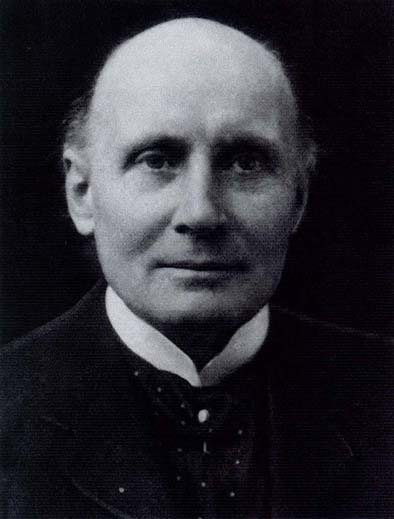
Alfred North Whitehead
Whitehead gave me the language to talk about the Big Whole and my nature as a part of the Big Whole (an undergraduate paper I wrote on Whitehead's influence on Henry A. Murray later was published; see J. of the History of the Behavioral Sciences 9(3): 251-257), but he couldn't explain to me why I continued to experience myself as alienated from the Whole. At this point in my life, of course, I can see how his principle of "extensive abstraction" might account, at least in part, for the distancing of ego from the world, but I didn't get it then.
Whitehead, of course, had nothing to say about the neurophysiological structures that mediate my experience. That came later. I recall trying to work all that out at the Makerere University guest house in Kampala, Uganda, in 1969, while waiting to get all the paperwork I needed to get myself and my family into the field among the So in Karamoja District.
With the aid of judicious doses of LSD-25 (about 5 or 6 "trips," all but one well planned a la Tim Leary's scheme, between 1966 and 1969), I came to realize that one could experience harmony with the Big Whole through a unitary intuition that effected perception and affect, indeed, every way of knowing. I learned that my usual state of mind was a construction of my consciousness and had a lot to do with my inability to experience connection with the world. I learned that I am actually never separate from the world and that the world is continuously feeding me and I am feeding it. The boundaries of "me" are very permeable, and where "I" begin and leave off is a matter of taste and conditioned view.
I was a philosophy major in San Francisco then (what else!). But those were the days of avid Kantian transcendentalism, and when I got a B- for doing an 85 page paper on Gandhi's philosophy of satyagraha, I became disenchanted with what academic philosophy had to offer. Then one day a poet friend of mine named Julia Kooken gave me Colin Turnbull's Forest People to read. The book changed my life. Literally. A popular and well written account of the author's sojourn among the Mbuti Pygmies of the Belgian Congo (Zaire), it was for me proof-positive that there are human beings on the planet that routinely experience non-alienated mindstates. Here was the genuine UNALIENATED MAN! I changed my major and completed a B.A. in anthropology (1966) in just over a year.
It was at some point around 1969 that I figured out that my mindstates were how my brain experiences itself and its environment. I also became aware that people are walking around unaware that they are experiencing nervous systems. Once I was clear about this, I found the normal state of people is such a curious form of self-ignorance! It still intrigues me to this day. People have no trouble with the notion that they digest hamburgers with their stomachs, or that they pump blood with their hearts, or grasp at straws with their hands, but they seem to have trouble getting their minds around the idea that they think, feel, create, dream, imagine, experience, intend, act, etc., with their nervous systems. Rather, they do all this with their "mind" which is somehow distinct from (apart from, separate from, yes, ALIENATED FROM) their bodies.
I sensed there was a mind-body schism working here. Eureka! I began to understand how I, myself, had come to experience myself as alienated from the world. I relate to the Big Whole via my body, and I experience myself as a mind separate from "the" body, and hence the Big Whole. The problem became for me then a developmental neurophysiological one, and one that seems to begin with early conditioning -- the early pre- and perinatal alienation of the mind from the body -- an easy matter to accomplish given our (Euroamerican) obstetrics and our lousy culture of parenting.
Colin Turnbull Interviewing Pygmies
I got sidetracked doing a Ph.D. at the University of Oregon (completed in 1972), and by the time I was ready to go into the field, the political climate in Zaire was such that doing work with the Pygmies was out of the question. Colin Turnbull suggested a number of alternate possibilities and I chose to do ethnographic fieldwork among the So of northeastern Uganda ( Ethnography of the So of Northeastern Uganda , New Haven, CT: HRAF Press, 1979). [Colin and I had corresponded for some years since I first connected with him after reading his book I had wanted to go immediately to study the archer pygmies, which had not yet been researched, but Colin was a smart mentor and urged me to seek graduate training before entering the field -- advice his own mentor, Pat Putnam, had given him.]

Ivan A. Brady
The brain was never far from my mind, however (ho, ho!) -- even in the midst of doing ethnography -- for the African experience eventually led to collaboration with anthropologist Ivan A. Brady (fellow U of Oregon grad students) on our edited volume, Extinction and Survival in Human Populations (New York: Columbia University Press, 1978), which presents a biogenetic structural account of human cultural and psychological responses to various kinds of deprivation. Both Ivan and I had a great interest in the biological, neurological and social aspects of adaptation to deprivation. He taught me a lot about the adaptation of peoples living on small islands in the Pacific.
A crucial juncture in my work occurred when I met the late Eugene G. d'Aquili at a conference in 1972. Gene was a neurologically- trained psychiatrist/anthropologist and we immediately realized we had common interests in the relationship between brain, mind and culture. We collaborated in writing our first book, Biogenetic Structuralism (New York: Columbia University Press, 1974). Because the issues we were raising were new to anthropology, we only became aware of the work of the American neuroanthropologist, Earl Count , and the Swiss genetic epistemologist, Jean Piaget , as our book was going to press.

Eugene G. d'Aquili
Biogenetic structuralism takes the view that the structures producing universal patterns in culture -- i.e., universal patterns in socially conditioned beliefs, behaviors, techniques, images, thoughts, feelings, perceptions, experiences, etc. -- are in fact neurophysiological organizations (or "entrainments") that develop during the course of an individual's life, and that have their developmental origin in initial, genetically predisposed "neurognostic models" (or simply "neurognosis"). It is neurognosis that accounts for the regularities in language, dreaming, intuition, feeling, archetypal imagery, etc., found cross-culturally and that are ubiquitous to the human species.

Gene & Charlie in 1973
After meeting d'Aquili and working on Biogenetic Structuralism with him, I realized I needed to re-train myself in the neurosciences, so I applied for a postdoc with the National Science Foundation and, getting it, became a fellow of the Institute of Neurological Sciences at the University of Pennsylvania under Dr. Richard Sprague and Dr. William Chambers during 1973-74.
It was in Philadelphia (d'Aquili's home town) that d'Aquili and I met the late John McManus . McManus, trained as a social psychologist at Syracuse University, was an expert on Piaget and his critique of biogenetic structuralism quickly forced d'Aquili and I to become more developmental in our view of how the brain works. We even made some mumblings to that effect in BS as it was going to press just to assuage McManus. In addition, studying the writings of Earl Count influenced our understanding of evolutionary processes toward a consideration of what Count calls the "biogram."
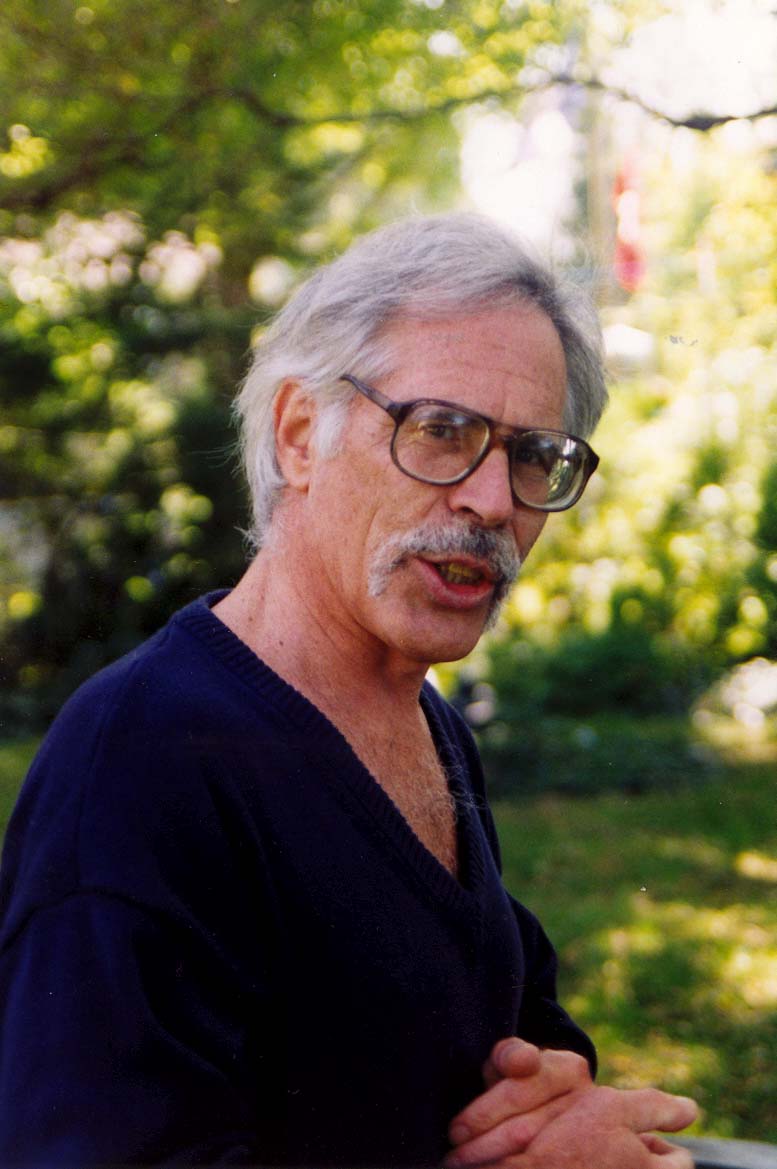
John McManus
Biogenetic structural theory has been very much a group endeavor (thanks primarily to Ivan Brady, Gene d'Aquili, John McManus, Sheila Richardson, Robert Rubinstein , and more recently Robbie Davis-Floyd and C. Jason Throop ), and has continued to develop over the last quarter century. We decided early-on that we needed to do a major study of a "universal" cultural institution as a practical example of how a biogenetic structural analysis could be done. In 1975, the year after the publication of Biogenetic Structuralism , Gene and I teamed up with John McManus and several other specialists in various fields to produce a book-length application of the approach to the evolution and nature of ritual ( The Spectrum of Ritual , New York: Columbia University Press, 1979). Ritual was chosen primarily because it is a human universal -- all cultures everywhere exhibit rituals -- and there existed a rich literature in the biology of ritual, especially in the ethology of animal social behavior. From the biogenetic structural point of view, if a behavior, institution, image or concept is universal, it can only mean that there is an underlying, genetically determined neural structure mediating that phenomenon.
As it turned out, the application of biogenetic structuralism to ritual led us to better understand science itself and its profound limitations relative to the study of consciousness. John McManus and I joined forces with anthropologist and philosopher of science, Robert A. Rubinstein , to write Science As Cognitive Process (Philadelphia: University of Pennsylvania Press, 1984), a book that explores the neurocognitive foundations of science. Unfortunately the press went through a change in management and ended up jerking us around, and the book did not receive very effective distribution.
Robert Rubinstein in Egypt
During the period from summer 1988 to well into 1992, I founded and sustained a network of neuroanthropologists for the purpose of encouraging cross-fertilization of ideas and sharing research. Out of this project came a number of symposia at professional meetings, and a four year run of what I called the Neuroanthropology Network Newsletter , the entire run of which is now available on this site. The various articles in it form an interesting history of the anthropological interest in things neurological.
Biogenetic structuralism has become steadily more phenomenological in its empirical grounding over the years, especially relative to the study of religion and spiritual practices, and led eventually to our most ambitious project to-date, Brain, Symbol and Experience (New York: Columbia University Press, 1990). In this work, John, Gene and I examined the relations between the brain, the symbolic function, and the phenomenology of experience in the study of consciousness. We advocated combining anthropology, the neurosciences and contemplation as the most productive way to explore and model consciousness.

Venerable Namgyal Rinpoche
During the late-1970's and early 1980's I got involved in researching systems of meditation, particularly those practiced by Tibetan Buddhists. I became a monk (lama) for some years and spent a lot of time in Tibetan and other Buddhist monasteries in Nepal, India and elsewhere (I never strayed over into Tibet, however) learning to meditate, and learning the psychology of their elaborate, highly archetypal symbolic system. Much of my study was under the tutelage of the late Venerable Namgyal Rinpoche , a Canadian-born Buddhist teacher, and Venerable Chogye Trichen Rinpoche , a profoundly gifted and high ranking Tibetan meditation master.
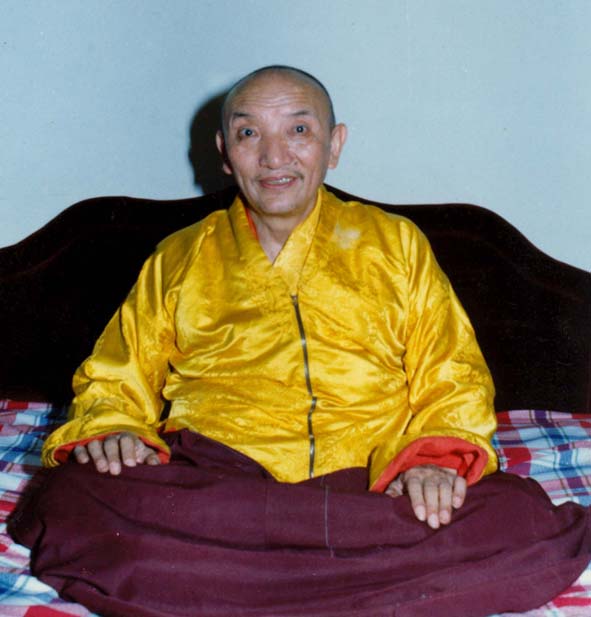
Venerable Chogye Trichen Rinpoche
Lumbini, Nepal, fall 1981
Click here for more pictures of Chogye Rinpoche
The course of meditative practice and resulting maturation of intuitive realizations is hard to describe. It is a process that is so subjective, and yet it transforms one's view of self and world in such profound ways, that to describe the process in detail for people who have not followed some form of full-blown spiritual path is virtually impossible. Beyond any doubt, it had effects upon my personal version of biogenetic structuralism. For instance, at some point along the contemplative path one comes to realize there is no permanent substance to anything in conscious experience, including the self. The conception of a permanent ego is utterly disconfirmed by experience and falls away. One consequence of this is that one no longer expends so much energy looking for the little homunculus in the brain, or "the ghost in the machine" that was thought to be "me." Each moment of consciousness is directly seen to be a fresh construct which arises and passes leaving no residue, save perhaps karma.
My meditative work was usually carried out in lengthy retreats in my apartment or later on in my home on the banks of the Gatineau River in Quebec -- or some retreat center or monastery in such places as Lumbini, Nepal, Samye Ling in Scotland, the Benedictine priory in Montreal (under the benevolent eye of the late Dom John Main), a cabin on the banks of Lake Laberge near Whitehorse in the Yukon, and the like. As a consequence of this work I came to realize many facts about consciousness that have fed my writings, including what the full-on experience of loving kindness is like, what Jesus meant by the koan, "before Abraham was I am," what the experiences of the Bardo are like, that all sensory experience consists of particles (or "dots"), that the overall organization of every moment of consciousness is largely due to intentionality, that time consciousness is a cognitive binding together of sensorial epochs, that archetypes are actual in the being and tend to come alive and to perfect and simplify themselves in visions, fantasies, dreams and projections when the ego-will is not functioning, so forth.
The interest in introspective methodology in the study of consciousness eventually lead me to study the writings of the great phenomenologist, Edmund Husserl . He showed that the best way to ground the various sciences of humanity was to first understand our own consciousness by direct introspective methods -- methods that require the researcher to become essentially a mature contemplative. He taught that phenomenology is not just another armchair philosophy, but rather is a method of self-exploration requiring training and discipline. Exercise of these skills brings the practitioner to directly adumbrate, bracket and study the essential properties and processes of consciousness.
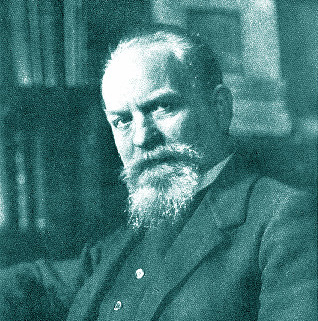
Edmund Husserl
In studying Husserl's methods I came to conclude that they were very similar to methods used in Buddhist psychology for coming into direct experience of these essential structures of consciousness. And as I hold that any universal properties of mind must be due to invariant structures and processes of the human nervous system, this led me in the late 1980s to formulate a perspective I called neurophenomenology . This became an integral part of the perspective taken in what I consider the best effort that the biogenetic structuralist group has produced, that being our book Brain, Symbol & Experience: Toward a Neurophenomenology of Human Consciousness, published first in 1990 by Shambhala, and later on by Columbia University Press.
As I said above, along the way I became concerned with mapping the relevance of early fetal and infant brain development and experience for a more realistic anthropological theory of enculturation (see articles in Anthropologica 31:135-178, 1989, and in Human Nature 2(3):147-165, 1991). After all, most of the development of the brain occurs in the womb and in the first year after birth. My involvement in the pre- and perinatal psychology field was also a direct consequence of realizing the root origin of my own neurosis to be pre- and perinatal trauma. I learned this during the course of meditation and dream analysis. This led me to become involved with Dr. Thomas Verny , a well-known psychiatrist and author of The Secret Life of the Unborn Child . I became a member of the Association for Pre- and Perinatal Psychology and Health , and was for a time the editor of the Journal of Pre- and Perinatal Psychology , later changed to the Journal of Pre- and Perinatal Psychology and Health .
Meanwhile, and with respect to my own research, I shifted my ethnographic interest in the 1990s from Tibetan Buddhism to Navajo philosophy and ritual healing practices, and have spent six periods living with Navajo friends on their reservation in New Mexico. I was particularly interested in getting at the experiences behind their concept of hozho , usually translated as "beauty," but actually nearly impossible to translate succinctly considering it also connotes healthy, ordered, harmony, etc. I was interested in how this concept related to day-to-day experience, as well as how it comes alive in healing rituals. It took quite some time to comprehend just why hozho lies at the center of all of Navajo philosophy and psychology. I have yet to write an article about the concept, but I intend to, for I think it holds the key to understanding a very crucial principle by which culture and especially ritual can condition neurocognitive functioning.
I continue my interest in the total range of human experience, including various kinds of transpersonal experiences that arise during lucid dreaming, meditation, drug trips, etc. My interpretation of this enormous spectrum of mindstates is that it provides evidence of the flexible range of entrainments of which the human brain is capable ( Western Canadian Anthropologist 5:29-60, 1988). In a way, transpersonal anthropology is the fulfillment of the vision of what psychological science could become in William James' "radical empiricism."
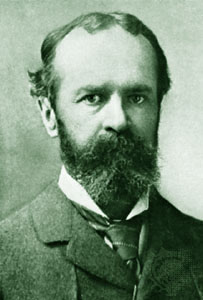
William James (late 1800s)
I also have an abiding interest (begun with McManus in the 1980s) in modeling the role of play in neurocognitive development ( Play and Culture 3(3):173-192, 1990). It is interesting that one of the last things that Victor Turner wrote (see his 1983 paper "Body, Brain, and Culture." Zygon 18 (3): 221-245) took us to task for not paying enough attention to play. Unbeknownst to him we had just started to do just that (see McManus' and my 1982 paper "The Biopsychological Determinants of Play and Games." in Social Approaches to Sport. ed. Robert M. Pankin. Rutherford, NJ: Farleigh Dickinson University Press).
I attended a couple of Institute of Noetic Sciences (IONS) conferences and then wrote a monograph for IONS on causality and meaning. In that piece I explain why science is so good at producing causal explanations, but is lousy at producing meaningful experience for the people whom science affects. Completing that task led me to a more direct encounter with the interest in philosophy that marked my early intellectual growth. I have been slowly putting together a book tentatively entitled Truth and Structure that concerns itself with the processes by which we "true-up" our theories of self and the world.
All of which is to say that I continue to better understand the relationship between the cognized and operational environments. I am increasingly conceiving the operational environment in terms of modern quantum physics, and especially in terms of the new physics of the vacuum [the so-called zero point energy (ZPE) sea]. A number of years ago, Bob Jahn and Brenda Dunne of the Princeton Engineering Anomolies Research (PEAR) Labs at Princeton University, who I had met earlier at an IONS conference, invited me to join a small group of scientists who came to call themselves the International Consciousness Research Laboratories ( ICRL ) and who carry out various collaborative explorations at the fringes of science. One of the members of that group is Harold E. Puthoff with whom I have had a delightful and enlightening dialogue over the years. Hal Puthoff is one of the leading physicists of the new physics of the vacuum (ZPE sea), and has been wonderfully patient in explaining the world according to physicists to a neuropsychological anthropologist.
It seems to me at this point that the operational environment consists of the relatively dense, coherent energies that constitute the locality of an organism. The emphasis here is upon dense and coherent loci of energy. Not the entire universe. local or otherwise. Or to put it in other words, the operational environment is that aspect of the energy spectrum that comprises the organism and all the material things the organism must adapt to in order to get food without becoming food. What has always saved the cognized environment - operational environment distinction from being just another dualism is the fact that the organism, as well as the organism's brain, in which the cognized environment arises (is constituted) is also part of the operational environment. Part of the operational world to which the organism's brain must adapt is indeed it's own nature. And part of its nature is local and part of its nature is quantum and distributed throughout the universal sea of ZPE. Coming to know one's distributed nature is what many people mean by "spirit" or "totality".
I have recently collaborated with my friend and fellow anthropologist, C. Jason Throop , to more fully develop the phenomenological orientation implicit within biogenetic structural theory. We have founded a perspective we call c ultural neurophenomenology 䨡t is, the application of a trained phenomenology that controls for cultural variation in perception and interpretation, coupled with knowledge from the neurosciences about how the organ of experience 䨥 brain 鳠structured, develops and operates. Thus far we have utilized this framework to explore the cross-cultural and neuropsychological factors in the experience of emotion, including the emotional aspects of higher states (Laughlin & Throop, 1999), the role of myth and cosmology in "trueing-up" the relationship between experience and reality, the importance of alternative states of consciousness in furthering the veridicality of experience, the interpenetration of experience and extramental reality, how viewing experience, reality and culture in terms of information allows an integrated perspective in anthropology, and a modern re-interpretation of Emile Durkheim's "collective effervescence."

Charlie Laughlin and Jason Throop
This is the end of the personal account of my involvement in the foundation of biogenetic structuralism for the moment. If you got here from the biogenetic structuralism web page , you can return there. If you are reading this while doing the self-guided tutorial, then you can return to the tutorial introduction . And if you would like to return to the tutorial index , please do so.